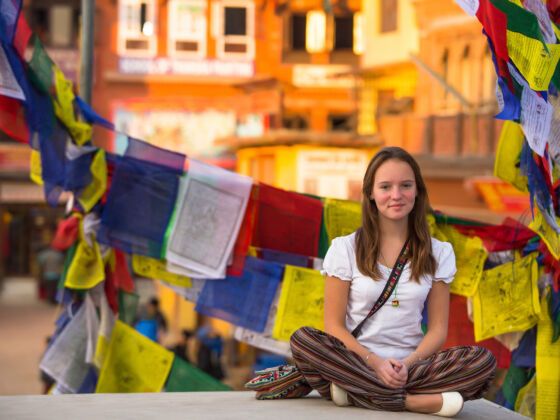On April 25, 2015, a magnitude 7.8 earthquake hit the Gorkha District of Nepal. It was followed by a large aftershock on May 12. Over 8000 people died, 21,000 were injured and 900,000 houses were damaged or destroyed. In April 2016, during the peak of Nepal’s spring tourist season and in the week before the one-year anniversary of the earthquake, I travelled to Pokhara and the Annapurna Himalayas to find out how tourism in the country is faring.

It's Been One Year Since the Devastating Nepal Earthquakes. Here's What It's Like to Travel Here Now.
The attractive lakeside city of Pokhara is Nepal’s second city, watched over by forested hills that gradually become pointy snow-capped peaks. Despite too many shops selling tourist tat and fake branded trekking gear, many visitors to Nepal have a soft-spot for Pokhara. Its air is cleaner than Kathmandu’s, the traffic less manic, the pace slower, and happy-hour cocktails come with colourful names like ‘Sex in the Lake.’ Spring is one of Nepal’s peak tourist seasons (the other is autumn) as the weather is warm and generally dry, making conditions ideal for the outdoor activities the country is famous for. Pokhara, in April 2016, was quieter than usual, with restaurants only half-full on a weekend evening, and no problems booking good-quality, low-cost hotels. Yet this is an improvement on visitor numbers in 2015.
Pokhara and the Annapurna Himalayas are situated in the western part of Nepal, which was not affected by the 2015 earthquakes, yet tourism suffered all around the country after the earthquakes. Things in Nepal may not quite be back to normal yet—homes and important cultural sites are still being rebuilt, and the government is struggling to meet its promises and obligations regarding relief and rehabilitation—but there is reason for the tourist industry to be hopeful.
Tourists were initially scared off because of uncertainty about Nepal’s ability to host visitors after the disasters. But as word spread that only a small number of regions of interest to tourists were badly damaged, visitors have trickled back.
Shiva Dhakal of Royal Mountain Travel, a travel company specialising in trekking holidays, believes that by the end of 2016, visitor numbers to Nepal should be on a par with pre-earthquake levels. His company’s bookings dropped by 70% in 2015, but have already improved in 2016. Similarly, Maila Gurung of GRG’s Adventure Kayaking believes that although it has been a tough year with the earthquakes and then the prolonged effects of a fuel shortage caused by political unrest on the Indian border, tourist arrivals should be back to pre-earthquake levels by the end of this year.
On a larger international scale, faith in Nepal’s ability to host tourists has also been expressed. A boost to the spirit of the Nepali people came in March 2016 when the UK’s Prince Harry visited Nepal. Monarchist or not, Harry’s stay and his warm interactions with ordinary Nepalis boosted positive media coverage of Nepal. As Maila Gurung laughed: “If Nepal is good enough for Prince Harry, it’s good enough for you!” Arguably more significant is that the United States has now lifted the travel advisory against travel to Nepal, and Rough Guides have listed Nepal as the number one country to visit in 2016. They stated: “Thoughtfully spent tourist dollars will go a long way here; choosing independent homestays and grassroots tour companies ensures money ends up in local pockets.”
The point where tourism and responsible development meet is crucial to Nepal’s tourism industry. Much international aid was offered after the earthquakes because of the goodwill that Nepal has generated over the years as a welcoming, rewarding travel destination. The country relies heavily upon repeat visitors who fall in love with it and realize that one trip is not enough. British kayaker Liam Kirkham is one such fan. He has visited Nepal five times since 2001, and is preparing for his sixth later this month. He will soon be making his second post-earthquake trip to the country, and says that he hasn’t been put off by the earthquakes because the people are still kind, and the scenery is still beautiful.
After Pokhara, I ventured into the Annapurna Himalayas on the five-day Annapurna Community Trek. This little-known trekking route was developed by Magsaysay Award winning social entrepreneur, Mahabir Pun, who grew up in this region. (Pun is celebrated for his work developing remote communities through wireless technology). Accommodation on this trek allows personal interaction with ordinary villagers, through homestays and community lodges, which provide a simple but clean, safe and comfortable place to stay. Walking the Annapurna Community Trek epitomizes what the Rough Guides recommend travellers in Nepal do this year and beyond: stay in local homestays run by grassroots organisations.
This particular route has the added benefit of, at present, being extremely under-visited: my friend and I didn’t encounter any other tourists all week. Even if visitor numbers were to increase tenfold in the near future, the Annapurna Community Trek would not see anywhere near the same kind of foot-traffic as other nearby trekking routes, such as Poon Hill or the Annapurna Circuit. The close-up views of some of the highest mountains in the world—including the fishtail of Macchapucchre and the 8000-metre-plus Dhaulagiri — are just as spectacular as elsewhere in the region. Rarely is waking up at 5.30am something to look forward to, but with the sky tinged pink and the orange rays of sun creeping from behind the pointy peaks, sunrises are a highlight of any trek in the Himalayas. And while solitary high-altitude sunrises are the stuff that dreams are made of, this fan of Nepal hopes that they won’t remain solitary for too much longer, because that would signal that tourism in Nepal is truly back on track.
The author was a guest of Royal Mountain Travel on the Annapurna Community Trek, but all opinions are entirely her own.